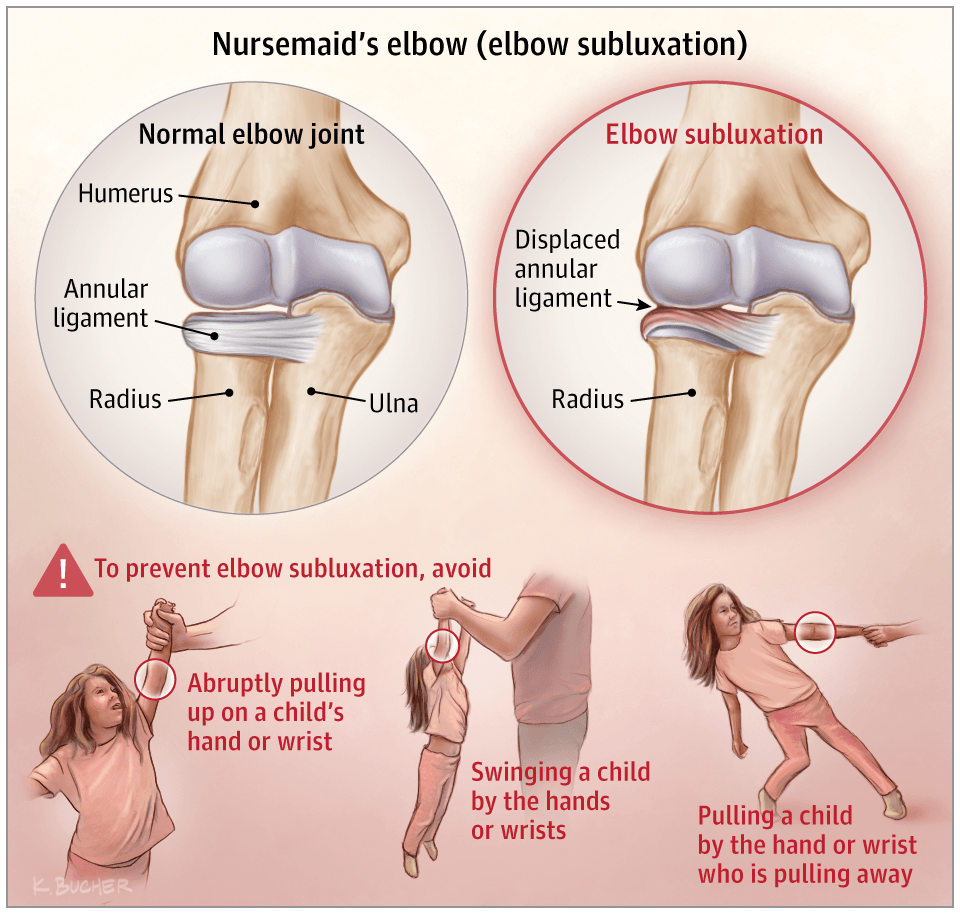Causes & Treatment of Nursemaid’s Elbow
- Category: General
- Posted On:

What Is Nursemaid's Elbow?
Nursemaid’s elbow, also called a pulled or slipped elbow, is an early childhood injury. It happens when a child’s elbow is pulled and the annular ligament, an elastic tissue that holds bone together, slips out of place and becomes stuck in-between the joints, partially dislocating the elbow. The medical term for nursemaid’s elbow is “radial head subluxation” or “annular ligament displacement” — it may sound scary, but it’s a common injury that we can easily treat here in the office setting.
What Causes Nursemaid’s Elbow?
Nursemaid’s elbow usually happens to children between the ages of 1-4, though it can happen anytime from birth to around 6 years old. The bones and ligaments are still growing in small children, resulting in the ligaments being a bit loose. Because of this, it takes very little force to pull the joints of the elbow out of place, resulting in nursemaid’s elbow. As children grow, their ligaments get stronger and tighten up, reducing the risk of this painful condition. The ligaments in the joint may be particularly loose in some children, which may lead to recurring nursemaid’s elbow in approximately 25% of those affected.
While nursemaid’s elbow is rarely caused by falls, it can easily happen in day-to-day situations inadvertently. It only takes a small amount of force to cause the ligament to slip. Even young infants or toddlers rolling themselves over in an awkward way can cause the ligament to slip out of place. Nursemaid’s elbow can occur:
- When pulling a child up by their hands, wrists, or arms. Always pick up children by lifting them from under the armpit. Never pull up a child by their arms, hands, or wrists.
- By suddenly tugging or pulling a child’s arm when leading a child or grabbing his/her hand, especially when a child is resisting or going in a different direction.
- Pulling a child’s arm through a coat sleeve with too much force.
- From swinging a toddler/young child around or back-and-forth by their hands or arms during play.

Image source: Jama Network
Signs and Symptoms of Nursemaid’s Elbow
Nursemaid’s elbow is painful, and children will usually cry and keep the injured arm by their side, avoiding using the arm. Often, they use the opposite hand to support the injured elbow. However, the injury is easily treated, relieving the pain while causing no permanent damage.
Nursemaid’s elbow doesn’t typically cause swelling or visual deformity, so it can be difficult to tell if a child has nursemaid’s elbow or a more serious injury.
When to Seek Medical Attention
Arm or elbow injuries can also result in an elbow fracture, and it can sometimes be hard for parents to distinguish between nursemaid’s elbow and a fracture. It’s important to have your child evaluated by a medical professional if he has injured his elbow. X-rays are not usually necessary to diagnose a pulled elbow, but they can be helpful to rule out a more serious injury.
You should not try to straighten the arm or move the elbow back into place yourself — you could cause more serious damage.
Nursemaid’s elbow is treated with a simple manipulation of the elbow in our office, usually with the child sitting on a parent’s lap while the doctor or Physician Assistant quickly but gently moves the joint back into place. A small pop may be heard when the joint slips into place. This procedure is called “reduction,” and it only takes a few seconds. It can restore normal range of movement and relieve the pain almost instantly. Most children are able to use their arm again within 15 to 30 minutes. Occasionally it takes a couple attempts to fix the joint, so the child is monitored in the office until we are sure they are able to use the arm normally. Usually no follow up is needed for the injury.
If you suspect nursemaid’s elbow, you should bring your child to our office to be evaluated as quickly as possible. We offer walk-in orthopedic appointments 6 days a week. Learn more about same day care.

.1).jpg)
.jpg)
